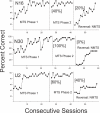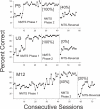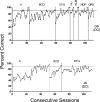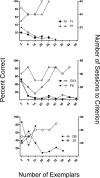Matching- and nonmatching-to-sample concept learning in rats using olfactory stimuli
- PMID: 21909161
- PMCID: PMC3168884
- DOI: 10.1901/jeab.2011.96-139
Matching- and nonmatching-to-sample concept learning in rats using olfactory stimuli
Abstract
Previous research has shown that rats can learn matching-to-sample relations with olfactory stimuli; however, the specific characteristics of this relational control are unclear. In Experiment 1, 6 rats were trained to either match or nonmatch to sample in a modified operant chamber using common household spices as olfactory stimuli. After matching or nonmatching training with 10 exemplars, the contingencies were reversed with five new stimuli such that subjects trained on matching were shifted to nonmatching and vice versa. Following these reversed contingencies, the effects of the original training persisted for many trials with new exemplars. In Experiment 2, 9 rats were trained with matching procedures in an arena that provided for 18 different spatial locations for comparison stimuli. Five subjects were trained with differential reinforcement outcomes and 4 with only one type of reinforcer. Differential outcomes and multiple exemplars facilitated learning, and there was strong evidence for generalization to new stimuli for most rats that acquired several conditional discriminations. Performances with novel samples were generally above chance, but rarely reached the high levels obtained during baseline with well-trained stimulus relations. However, taken together, the data from the two experiments extend previous work, show that rats can learn both match and nonmatch relations with different experimental protocols, and demonstrate generalization to novel sample stimuli.
Keywords: abstract concepts; identity; matching-to-sample; oddity; rats; reversal learning.
Figures








References
-
- Bodily K.D, Katz J.S, Wright A.A. Matching-to-sample abstract-concept learning by pigeons. Journal of Experimental Psychology: Animal Behavior Processes. 2008;34(1):178–184. - PubMed
MeSH terms
LinkOut - more resources
Full Text Sources

